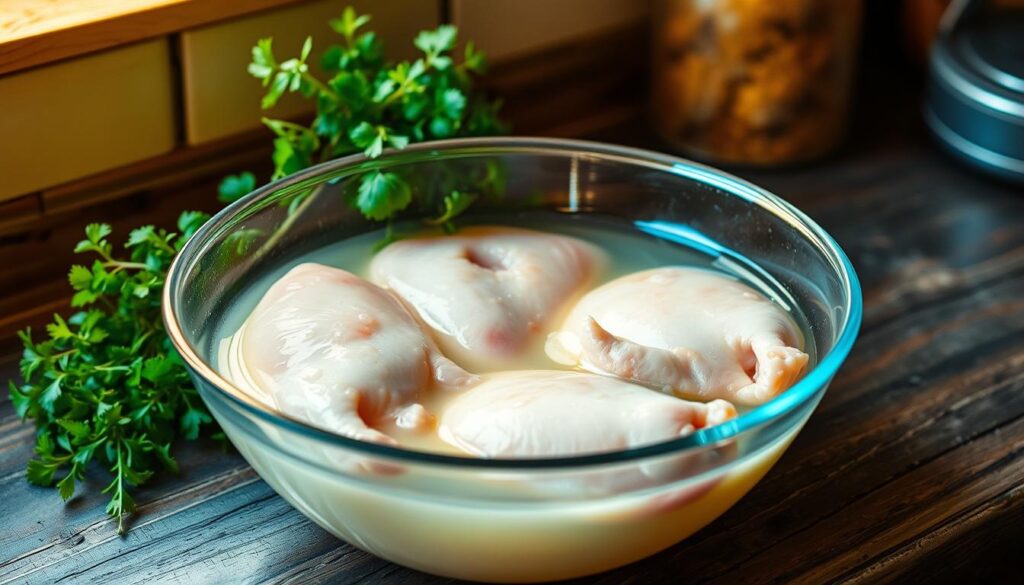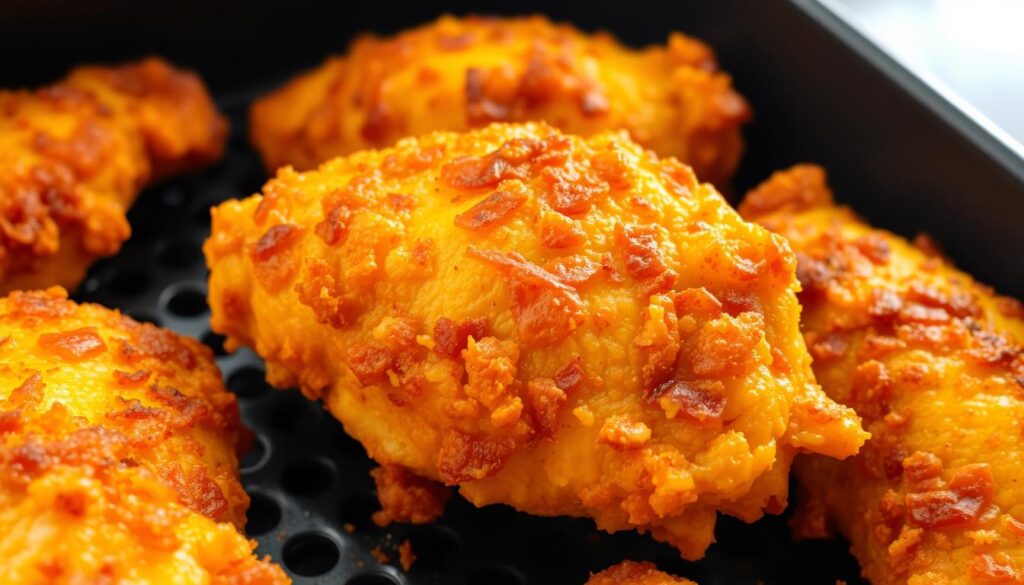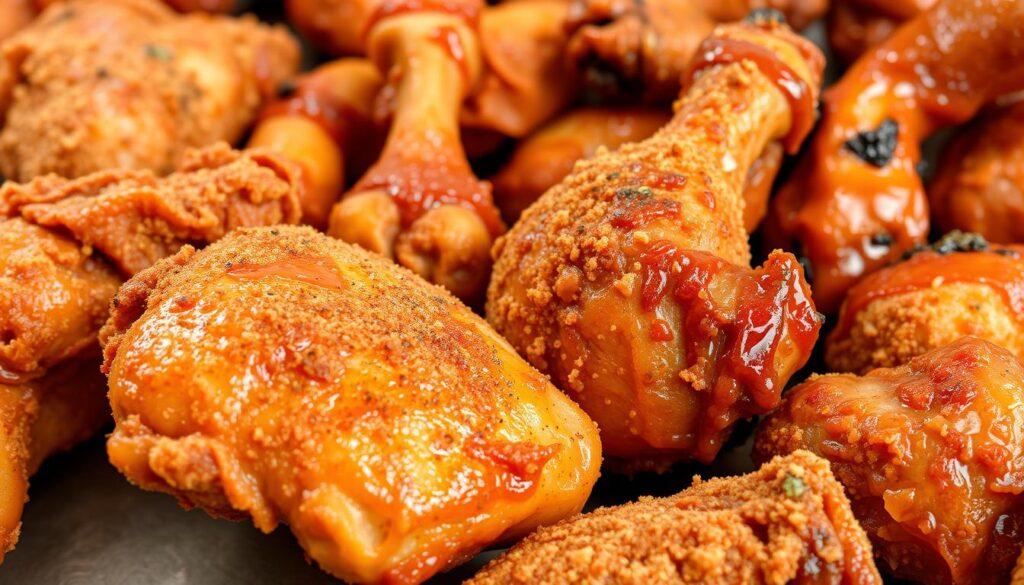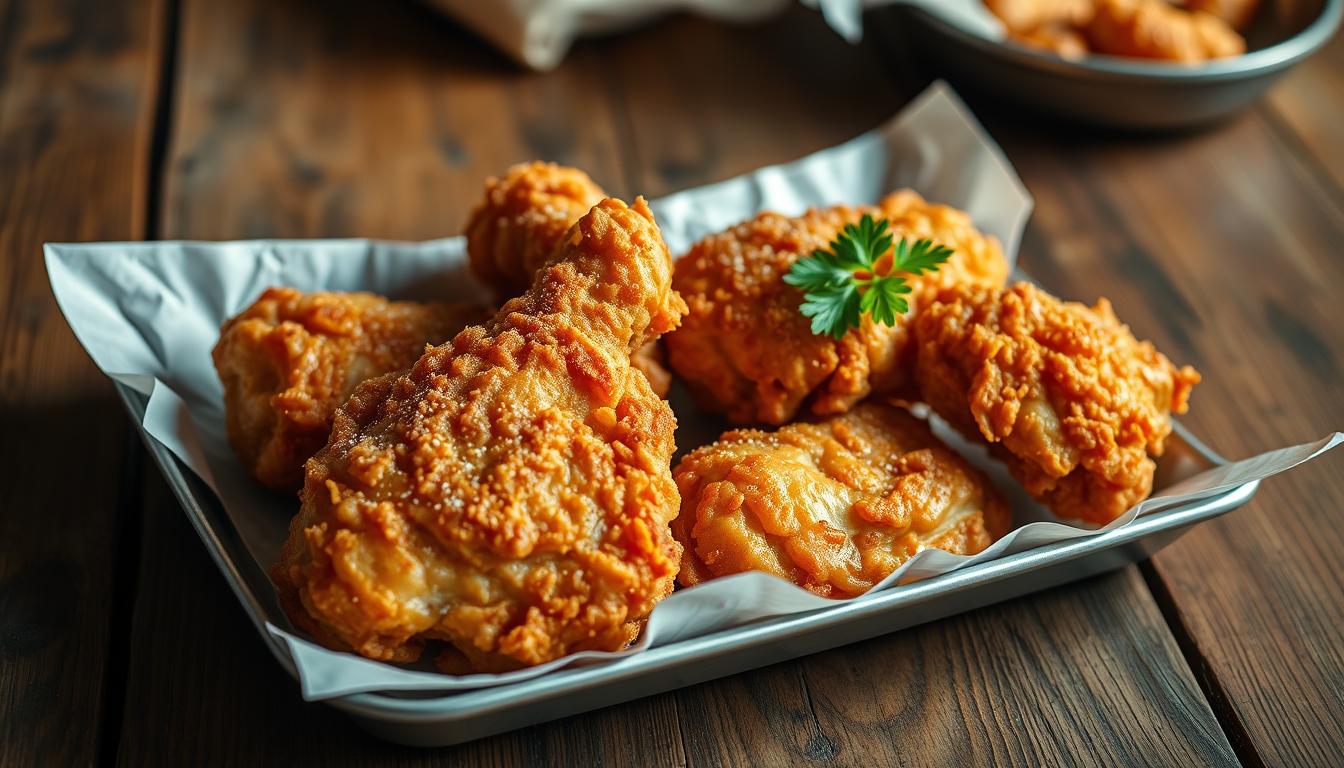Crispy chicken in an innovative way
Are you tired of serving soggy fried chicken to your family and friends? Imagine being able to achieve that perfect crunchy exterior and juicy interior every time, just like your favorite restaurant.
Discover how to make crispy chicken in an innovative way with our easy-to-follow recipes and cooking tips. Get cooking now!
Discover the secrets to making restaurant-quality crispy chicken at home with simple yet innovative cooking techniques. By understanding the science behind achieving perfect crispiness and experimenting with different ingredients and flavor profiles, you can elevate your cooking to the next level.
Key Takeaways
- Learn how to achieve a crunchy exterior and juicy interior with innovative cooking techniques.
- Understand the science behind achieving perfect crispiness in fried chicken.
- Explore different ingredients and flavor profiles to elevate your cooking.
- Discover simple troubleshooting tips for common problems in cooking crispy chicken.
- Get inspired by various serving suggestions to take your crispy chicken to the next level.
The Appeal of Perfect Crispy Chicken
The perfect blend of crunch and juiciness makes crispy chicken a beloved dish worldwide. You crave that satisfying crunch that gives way to tender, juicy meat inside. This contrast is not just pleasing to the palate but also engages multiple senses, making the experience of eating crispy chicken truly memorable.
Why We Crave That Crunch
Our brains are wired to enjoy contrasting textures, which is why crispy foods like fried chicken trigger strong cravings. The sound of biting into crispy chicken enhances our perception of its taste and quality, making it a comfort food across cultures. You enjoy the sensory experience that comes with each bite.
The Balance Between Crispy Exterior and Juicy Interior
Achieving the perfect balance between a crispy exterior and a juicy interior is a culinary challenge. Breaking down a whole chicken into parts and using a brine of buttermilk and hot sauce can help. This technique ensures the chicken remains tender and seasoned while creating a dry, crisp exterior.
| Technique | Benefit |
|---|---|
| Breaking down a whole chicken | Retains juiciness, allows for varied frying options |
| Using a buttermilk and hot sauce brine | Tenders the chicken, adds flavor to the bone |
The Science Behind Crispy Chicken
The secret to achieving crispy chicken lies in understanding the science behind it. To make your fried chicken crispy, you need to control the factors that affect its crispiness.
How Moisture Affects Crispiness
Moisture is the enemy of crispiness. When you coat chicken with a layer of flour or batter, excess moisture can prevent it from becoming crispy. Properly drying the chicken before coating is essential. When chicken is placed in hot oil, the surface moisture rapidly evaporates, creating a dehydrated outer layer that becomes crisp through the Maillard reaction.
- Excess moisture prevents crispiness.
- Drying chicken before coating is crucial.
The Role of Temperature in Creating the Perfect Crust
Temperature control is crucial in achieving the perfect crust. Frying at a temperature between 340-350°F allows for gradual moisture evaporation from the coating while cooking the meat inside. Using an oil with a high smoke point, like peanut or safflower, ensures that the flavor remains neutral throughout the frying process.
Essential Ingredients for Crispy Chicken in an Innovative Way
The secret to making irresistible crispy chicken lies in the quality of the ingredients used. To achieve the perfect crispy exterior and juicy interior, you need to choose the right components.
Choosing the Right Chicken Cuts
Selecting the right chicken cuts is fundamental. Opt for smaller, bone-in pieces as they provide better flavor and juiciness. These cuts have an optimal ratio of bone to meat, ensuring even cooking. Smaller chickens, typically between 2.5-5 pounds, yield better results due to their favorable meat-to-bone ratios.
The Power of Potato Starch and Specialized Flours
Potato starch and specialized flours play a crucial role in achieving crispiness. Italian Antimo Caputo ’00’ Flour is particularly effective due to its extra-fine grind, creating a delicate yet crispy crust. Mixing all-purpose flour with potato starch in a 2:1 ratio provides the perfect balance of structure and crispiness.
Selecting the Best Oil for Frying
The best oil for frying has a high smoke point, such as peanut, safflower, or canola oil. These oils can withstand prolonged cooking without breaking down or imparting unwanted flavors, ensuring your fried chicken stays crispy and delicious.
- Smaller, bone-in chicken pieces for better flavor and juiciness
- Innovative flour combinations, like Italian ’00’ flour, for superior crispiness
- Potato starch for an exceptionally crunchy texture
- Oils with high smoke points, such as peanut or safflower oil, for frying
The Magic of Brining
To achieve the perfect balance of crunch and juiciness, understanding the magic of brining is essential. Brining is a transformative process that uses salt and liquid to improve chicken’s moisture retention and flavor penetration through osmosis and protein modification.

Buttermilk Brine Benefits
A buttermilk brine offers dual benefits: the acidity tenderizes the meat by gently breaking down proteins, while the buttermilk’s components create a perfect base for flavor infusion. The ideal buttermilk brine ratio includes 3-4 tablespoons of salt per 8 cups of water, creating the perfect salinity for optimal moisture retention without curing the meat.
Flavor-Infused Brines
Flavor-infused brines can incorporate herbs, spices, garlic, and hot sauce to season the chicken from the inside out, creating layers of flavor that simple surface seasoning cannot achieve. The optimal brining time ranges from 8-12 hours, long enough to tenderize and flavor the meat without resulting in a mushy texture.
After brining, thoroughly drying the chicken is crucial for achieving crispy skin, as excess moisture will create steam during cooking that prevents proper crisping.
- Brining uses salt and liquid to improve chicken’s moisture retention and flavor penetration.
- Buttermilk brines tenderize the meat and create a perfect base for flavor infusion.
- Flavor-infused brines season the chicken from the inside out.
Innovative Battering Techniques
To achieve the perfect crispy coating on your fried chicken, it’s essential to master innovative battering techniques. The right batter can make all the difference between a soggy coating and a crispy, golden exterior.
The Double Dredge Method
The double dredge method creates superior crispiness by first coating chicken in dry flour, then dipping in a wet mixture, and finally coating again in seasoned flour—creating multiple layers that expand and crisp during frying. This technique ensures a crunchy coating that adheres well to the chicken.
Creating Texture with Clumpy Batter
Creating a textured, clumpy batter is achieved by adding a small amount of wet mix to the dry flour before dredging, forming clusters that create extra surface area for exceptional crispiness. Taking the time to pack the flour into each piece of chicken creates lots of craggy bits that fry up crisp and light.
Vinegar vs. Egg in Wet Batters
Using vinegar instead of egg in wet batters creates a lighter, crispier coating because it lacks the proteins that can make batters dense or chewy when cooked. For the wet batter, using white vinegar adds extra flavor to the batter and results in a very crunchy coating for your fried chicken.
Temperature Control Secrets
Achieving the perfect crispy chicken requires mastering temperature control. The ideal oil temperature is crucial for balancing exterior crispiness and thorough cooking.
Finding the Perfect Oil Temperature
The ideal oil temperature for frying chicken is between 340-350°F. Using a clip-on thermometer is essential to maintain a consistent oil temperature, as visual cues can be unreliable. Oil temperatures below 340°F result in greasy, oil-logged chicken, while temperatures above 360°F cause the exterior to burn before the interior is fully cooked.
| Oil Temperature (°F) | Result |
|---|---|
| Below 340 | Greasy, oil-logged chicken |
| 340-350 | Super crispy and golden brown |
| 360-375 | Dark exterior, sometimes burnt and raw inside |
The Low and Slow Approach
The “low and slow” approach involves cooking chicken at a lower temperature (325-350°F) to allow moisture to escape gradually from the coating while cooking the meat properly. When you add chicken to hot oil, the temperature drops; resist the urge to increase heat immediately, as a gradual return to the target temperature produces better results.
By adopting the “low and slow” method and maintaining the ideal oil temperature, you can achieve exceptionally juicy chicken beneath a crispy coating.
The Double-Fry Method
Double-frying is a technique that elevates the crispiness of fried chicken to new heights. This method, popularized in Korean fried chicken, involves frying the chicken twice to achieve exceptional crispiness.
Why Frying Twice Creates Extra Crispiness
Frying chicken twice creates a crunchier exterior by first cooking the chicken through at a lower temperature, then briefly frying again at a higher temperature. During the first fry, moisture within the coating is gradually released, creating a semi-dry layer; the second fry then dehydrates this layer completely, resulting in glass-like crispiness.
Timing Between Fries
The resting period between fries is crucial, typically lasting 5-10 minutes. This allows the chicken to release additional moisture that would otherwise prevent maximum crispiness. When you fry the chicken again, the time in the hot oil is much shorter, usually just 30 seconds to 1 minute, which is enough to crisp the exterior without overcooking the already-cooked meat inside.
Oven-Fried and Air-Fryer Alternatives

Crispy chicken lovers can rejoice with oven-fried and air-fryer alternatives that deliver on taste and texture without the need for a deep fryer. These methods not only reduce the amount of oil used in cooking but also provide a deliciously crispy exterior and a juicy interior, much like traditional fried chicken.
Achieving Crispiness Without Deep Frying
Oven-fried chicken achieves impressive crispiness by using high heat (400-425°F), a wire rack for air circulation, and a light spray of oil on properly coated chicken. Air fryers excel due to their intense hot air circulation, mimicking deep frying with less oil.
Adjustments for Different Cooking Methods
For both oven and air fryer methods, modifying the coating by adding a small amount of oil to the dry mixture helps achieve browning and crispiness. Preheating the cooking vessel before adding the chicken helps create immediate searing, locking in moisture. Time and temperature adjustments are necessary; air fryers cook faster, while oven methods may take longer.
Flavor Variations for Crispy Chicken
Elevate your crispy chicken game with a variety of flavor profiles that will tantalize your taste buds. You can achieve this by incorporating different seasonings and ingredients at various stages of the cooking process.
Spicy Variations
For those who love a bit of heat, spicy variations of crispy chicken can be achieved by adding cayenne pepper or chili powder to the dry mix. Using spicy sriracha mayo as a condiment can also add an extra kick. You can also incorporate heat into the brine with hot sauce or use pepper flakes in the flour coating.
Herb-Infused Coatings
Herb-infused coatings offer a fresh and aromatic twist. You can mix fresh or dried herbs like thyme, rosemary, and oregano directly into the flour mixture or infuse them into the brine. This adds a layer of complexity to the flavor of your crispy chicken.
International Flavor Profiles
Exploring international flavors can inspire unique and delicious variations. For example, Nashville hot chicken is known for its cayenne-based paste, while Korean fried chicken uses gochujang for a sweet and spicy flavor. Japanese karaage often incorporates ginger and soy, and Indian-inspired versions might use garam masala. You can also create a finishing spice dust by toasting and grinding spices, then sprinkling them on immediately after frying.
| Flavor Profile | Key Ingredients | Description |
|---|---|---|
| Nashville Hot | Cayenne pepper, brown sugar | A spicy and slightly sweet flavor profile characteristic of Nashville hot chicken. |
| Korean Fried | Gochujang, soy sauce, garlic | A sweet and spicy flavor with a deep umami taste. |
| Japanese Karaage | Ginger, soy sauce, sake | A savory and aromatic flavor profile with a hint of sweetness. |

Innovative Serving Ideas
Elevate your crispy fried chicken game with these innovative serving ideas. You can transform a classic comfort food meal by serving crispy fried chicken with a side of mashed potatoes and gravy, or get creative with unique pairings.
Beyond the Classic Sides
Move beyond traditional sides by pairing crispy chicken with unexpected companions. Try it with kimchi slaw, pickled vegetables, or a fresh herb salad to cut through the richness. For a gourmet twist, reinvent the classic chicken and waffles combination with different waffle variations, such as cornmeal or herb waffles.
Creative Dipping Sauces
Transform crispy chicken into a customizable experience with creative dipping sauces. Consider honey sriracha, garlic aioli, or Alabama white BBQ sauce for unique flavor combinations. These sauces can elevate the taste of your crispy fried chicken and add a personal touch to your meal.
You can also serve crispy chicken in a sandwich, with waffles, or as part of a grain bowl with quinoa and roasted vegetables. The versatility of crispy fried chicken allows you to experiment with various recipes and serving styles, making it a great addition to any meal.
Troubleshooting Common Crispy Chicken Problems
Even experienced cooks face challenges when making crispy chicken. Whether it’s the coating falling off or the chicken being undercooked, these issues can be frustrating. Fortunately, understanding the causes and implementing simple fixes can help you achieve perfectly crispy chicken every time.
When the Coating Falls Off
The coating falling off is a common issue, often due to inadequate drying before applying the flour. To prevent this, dry the chicken thoroughly with paper towels before coating. Creating a proper dredging sequence (dry-wet-dry) also helps form a strong bond between the chicken and coating.
Dealing with Undercooked Centers
Undercooked centers typically result from frying at too high a temperature. To avoid this, use a meat thermometer to ensure the chicken reaches a safe internal temperature: 165°F for white meat and 175°F for dark meat.
Preventing Greasy, Soggy Chicken
Greasy, soggy chicken often results from oil that’s too cool or overcrowding the pan. To prevent this, maintain the oil temperature at around 340°F and fry in batches if necessary. Placing fried chicken on a wire rack after cooking allows air to circulate, preventing sogginess.
| Issue | Cause | Solution |
|---|---|---|
| Coating falls off | Inadequate drying | Dry chicken thoroughly before coating |
| Undercooked centers | Frying too hot | Use a meat thermometer |
| Greasy, soggy chicken | Oil too cool or overcrowding | Maintain oil temperature, fry in batches |
Storing and Reheating for Lasting Crispiness
The key to enjoying crispy chicken at its best, even after a day or two, lies in how you store and reheat it. When dealing with leftover fried chicken, it’s essential to maintain its crispiness to enjoy it fully.
Best Storage Practices
To store leftover fried chicken, first allow it to cool down to room temperature. Then, transfer the chicken pieces to an airtight container or wrap them tightly in plastic wrap. It’s recommended to store the chicken in a single layer with paper towels between the pieces to absorb moisture. This method helps maintain the crispiness of the chicken. Refrigerated crispy chicken is best consumed within 3-4 days.
Reheating Methods That Maintain Crunch
For reheating, you can use either an air fryer or an oven. If using an air fryer, set the temperature to 330°F and heat the chicken for 3-5 minutes, checking and flipping it every 3 minutes to prevent burning. Alternatively, reheating in a 375°F oven on a wire rack allows for 10-15 minutes for the coating to re-crisp. Avoid microwave reheating as it creates steam that destroys crispiness.
As “Crispy chicken is a delight, but it’s even better when you can enjoy it crispy again the next day.” By following these storage and reheating tips, you can enjoy your crispy chicken at its best, even as leftovers.
Conclusion
Mastering the art of crispy chicken is a journey that combines science, technique, and creativity. You now have the knowledge to create delicious fried chicken and other chicken recipes at home. Experiment with different ingredients and cooking methods to find your signature style.
With the techniques covered in this guide, you’re well-equipped to produce restaurant-quality crispy chicken that will impress. Remember, great fried chicken recipes don’t require fancy equipment—just attention to detail and understanding the science behind the process.







